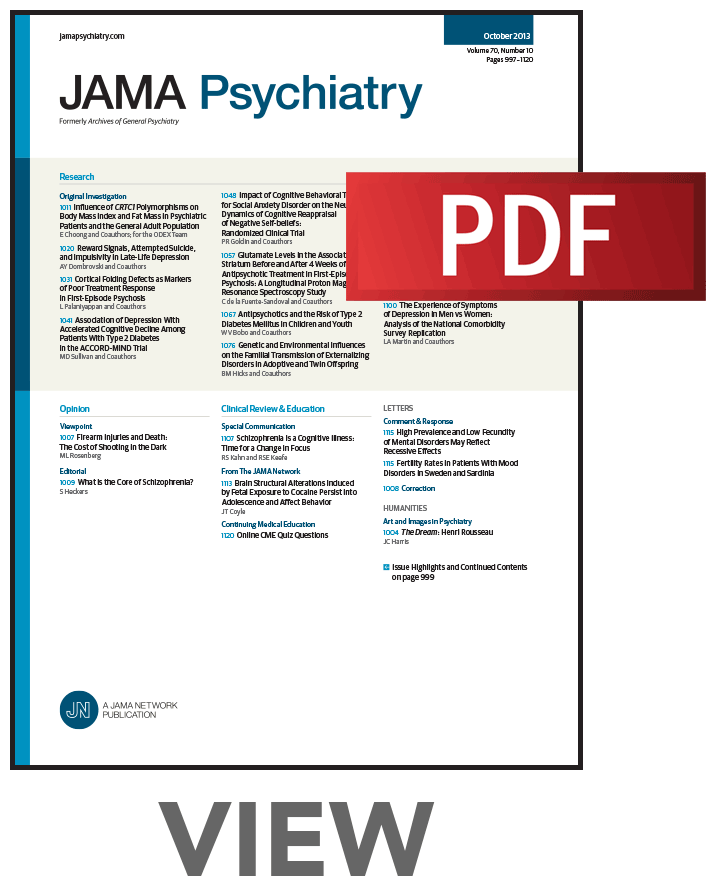药物使用障碍的心率变异性生物反馈:一项随机临床试验。
IF 17.1
1区 医学
Q1 PSYCHIATRY
引用次数: 0
摘要
初步研究表明心率变异性生物反馈(HRVB)可能会减少物质使用障碍(SUD)患者的渴望和负面影响,但很少有研究评估这是否转化为改善物质使用结果,并且之前没有研究在此背景下检查第二代可穿戴HRVB技术。目的评价第二代HRVB对成人SUD患者消极情绪、积极情绪、渴望、酒精及其他药物使用的影响。设计、环境和参与者这项2期随机临床试验包括8周的门诊治疗。招聘从2023年2月到2024年6月在美国各地进行。寻求治疗的成人SUD患者随机接受HRVB +常规治疗(TAU)或仅接受TAU治疗。干预:HRVB治疗8周。主要结果和测量方法主要结果为负面影响、积极影响、渴望和物质使用,采用生态瞬时评估法进行评估。结果在260例入选患者中,120例随机分为HRVB + TAU组或仅TAU组。在研究参与者中(69名女性参与者,115名[60.0%];平均[SD]年龄,46.18[11.59]岁),HRVB与负面情绪的显著减少相关(b, -0.01; z, -3.21; P =。b, -0.01; z, -4.60; P < 0.05。001)超过8周。相比之下,控制组的负面情绪和渴望都有所增加。在积极情绪方面没有观察到差异。HRVB还与AOD使用天数比例显著降低相关(优势比[OR], 0.36; 95%可信区间[CrI], 0.25-0.54),与对照组相比,AOD使用减少了64%。治疗条件缓和了渴望与后来AOD使用之间的人际关系(OR, 0.84; 95% CrI, 0.73-0.97),因此接受HRVB的人在渴望后使用AOD的可能性较小(b, -0.18; 95% CrI, -0.32至-0.03)。在这项随机临床试验中,研究结果表明,第二代HRVB可以减少SUD早期恢复个体的负面影响、渴望和物质使用。HRVB似乎通过破坏渴望与随后的AOD使用之间的联系而带来益处;这些结果支持HRVB作为一种潜在有效的治疗SUD的方法,值得在3期试验中进一步研究。临床试验注册号:NCT05454657。本文章由计算机程序翻译,如有差异,请以英文原文为准。
Heart Rate Variability Biofeedback for Substance Use Disorder: A Randomized Clinical Trial.
Importance
Preliminary studies suggest heart rate variability biofeedback (HRVB) may reduce craving and negative affect in individuals with substance use disorder (SUD), but few studies have evaluated whether this translates into improved substance use outcomes, and no prior studies have examined second-generation wearable HRVB technology in this context.
Objective
To evaluate the effects of second-generation HRVB on negative affect, positive affect, craving, and alcohol and other drug (AOD) use in adults with SUD.
Design, Setting, and Participants
This phase 2 randomized clinical trial included 8 weeks of outpatient treatment. Recruitment was conducted virtually across the US from February 2023 to June 2024. Treatment-seeking adults with SUD were randomized to receive HRVB + treatment as usual (TAU) or TAU only.
Intervention
Eight weeks of HRVB.
Main Outcomes and Measures
The primary outcomes were negative affect, positive affect, craving, and substance use, assessed with ecological momentary assessment.
Results
Of 260 individuals assessed for eligibility, 120 were randomized to receive HRVB + TAU or TAU only. Among study participants (69 female participants of 115 [60.0%]; mean [SD] age, 46.18 [11.59] years), HRVB was associated with significant reductions in negative affect (b, -0.01; z, -3.21; P = .001) and craving (b, -0.01; z, -4.60; P < .001) over 8 weeks. In contrast, the control group experienced increases in both negative affect and craving. No differences were observed for positive affect. HRVB was also associated with a significantly lower proportion of AOD use days (odds ratio [OR], 0.36; 95% credible interval [CrI], 0.25-0.54), representing a 64% reduction in AOD use compared to controls. Treatment condition moderated the within-person relationship between craving and later AOD use (OR, 0.84; 95% CrI, 0.73-0.97), such that those receiving HRVB were less likely to use AOD following craving (b, -0.18; 95% CrI, -0.32 to -0.03).
Conclusions and Relevance
In this randomized clinical trial, findings suggest second-generation HRVB can reduce negative affect, craving, and substance use among individuals in early recovery from SUD. HRVB appears to confer benefit in part by disrupting the association between craving and subsequent AOD use; these results support HRVB as a potentially efficacious treatment for SUD and warrant further investigation in phase 3 trials.
Trial Registration
ClinicalTrials.gov Identifier: NCT05454657.
求助全文
通过发布文献求助,成功后即可免费获取论文全文。
去求助
来源期刊

JAMA Psychiatry
PSYCHIATRY-
CiteScore
30.60
自引率
1.90%
发文量
233
期刊介绍:
JAMA Psychiatry is a global, peer-reviewed journal catering to clinicians, scholars, and research scientists in psychiatry, mental health, behavioral science, and related fields. The Archives of Neurology & Psychiatry originated in 1919, splitting into two journals in 1959: Archives of Neurology and Archives of General Psychiatry. In 2013, these evolved into JAMA Neurology and JAMA Psychiatry, respectively. JAMA Psychiatry is affiliated with the JAMA Network, a group of peer-reviewed medical and specialty publications.
 求助内容:
求助内容: 应助结果提醒方式:
应助结果提醒方式:


